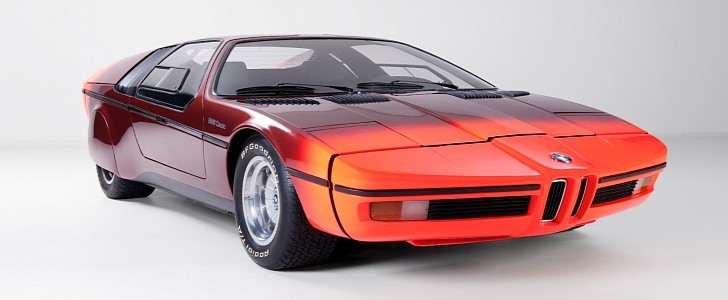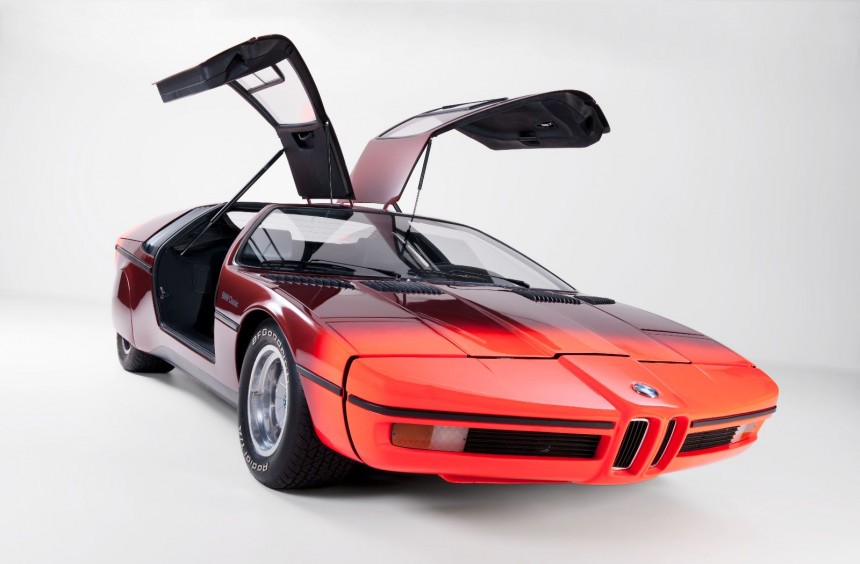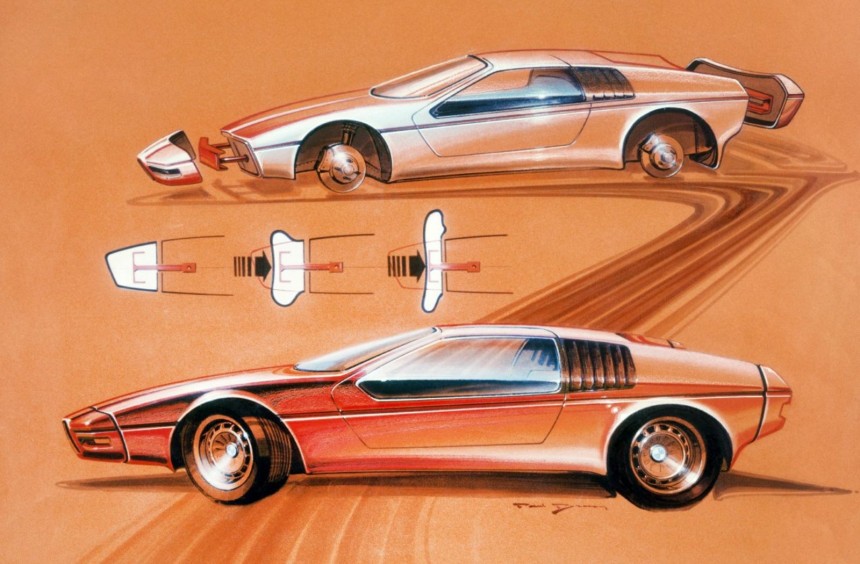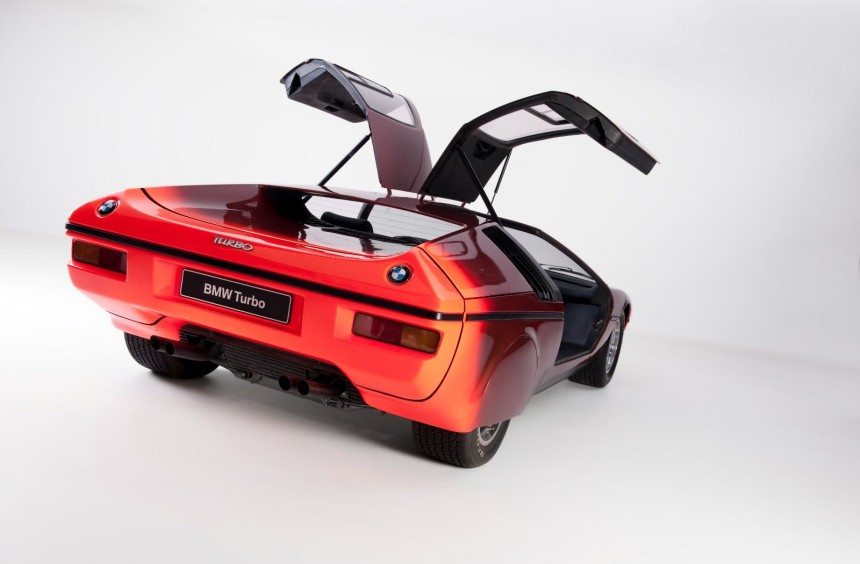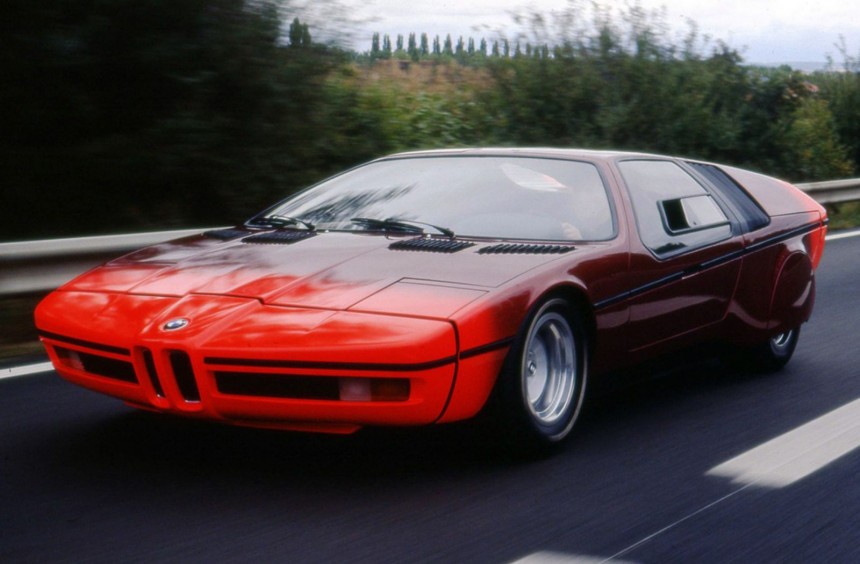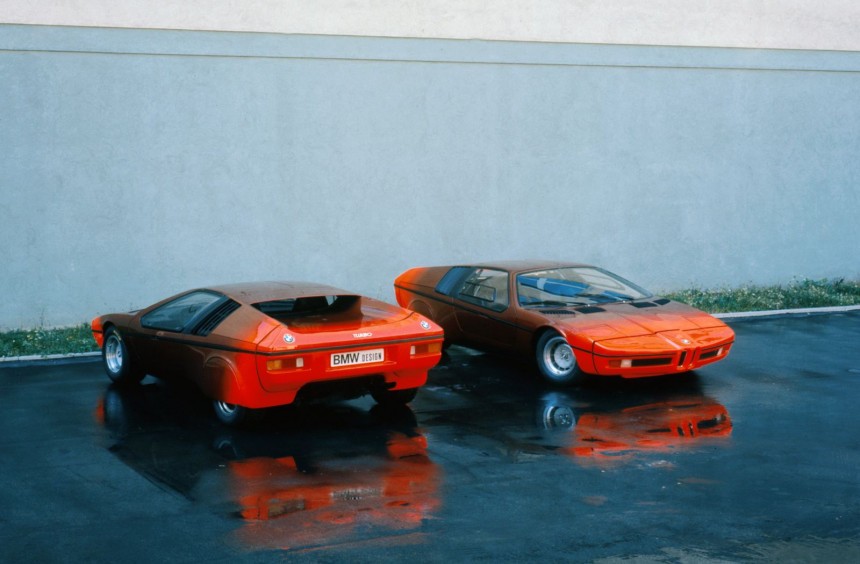While most attribute the creation of the M1 to Giorgetto Giugiaro, Gianpaolo Dallara, and the rest of the Italian partners who worked alongside the M division to shape the car, it all started with the Turbo, a futuristic concept designed in-house by the Bavarians.
During the early 1970s, as Munich was to host the 1972 Summer Olympics, BMW decided to mark the occasion by developing a cutting-edge show car. At the time, the company’s product range was comprised of only two model families, the compact 02 Series and the somewhat larger E9 coupes, so nobody was expecting a mid-engine sports car that seemed taken off the set of a science-fiction movie.
Although things didn’t go according to plan and the concept wasn’t completed fast enough to be presented during the aforementioned sporting event, when it was finally unveiled at the Paris Motor Show in October 1972, everyone was stunned by what lay before their eyes.
A wedge-shaped flying saucer on wheels with a unique burgundy paint job that faded to orange at the front and rear, the Turbo was designed by famous automotive stylist, painter, and sculptor, Paul Bracq.
It sat closer to the ground that any BMW-badged vehicle before it and featured a multitude of innovative design elements. Arguably the most spectacular was the large, gull-wing doors, but the rest of the bodywork was equally impressive.
Constructed to be as aerodynamically efficient as possible, it donned pop-up headlights, streamlined rear wheel covers, and a fine line that ran around the whole vehicle, rising slightly from the front to the back to not only improve airflow but also change the perception of the waistline, making the chassis look even lower.
However, this concept was not all about showcasing a futuristic design language. An engineering marvel of its era, it was a testbed for many advanced technologies, some of which would find their way into future production models.
At the time of its release, it was dubbed the safest sports car ever built due to the multitude of active and passive safety features it employed. Apart from being the first BMW equipped with ABS, it was fitted with a radar distance alert system, a collapsible safety steering column with three joints, doorposts that extended into the roof and provided rollover protection as well as bespoke foam-filled front and rear panels with embedded hydraulic shocks that were designed to absorb the brunt force of an impact.
Despite its low-slung body, the all-around view from the fighter jet-like cockpit was excellent. Moreover, the central console was angled towards the driver, a feature that has become emblematic for future generations of BMW vehicles.
In 1972, the German company also established the Motorsport division, which incorporated some of the brightest engineering minds that BMW had at its disposal. In addition to their first official project, the 3.0 CSL homologation special, the M division played a key role in the development of Europe’s first turbocharged production car, the 2002 Turbo. However, a year before this little monster was released, its chassis and powertrain served as the base for the groundbreaking Turbo concept.
With valuable input from M engineers, the chassis was modified, and a slightly revamped version of the 2.0-liter built for the 2002 Turbo along with a four-speed gearbox was mounted transversely behind the cockpit for improved weight distribution
A small and lightweight, four-cylinder, the M10 inline-four was so well-constructed and reliable that it was used to develop several racing units, including the 1,350-hp M12, also known as the most powerful Formula 1 engine of all time.
For the show car, the M10 was fitted with a Kühnle, Kopp & Kausch (KK&K) turbocharger and a Schafer mechanical fuel injection system that allowed it to produce between 200 and 280 hp, depending on boost pressure.
This meant that, according to the manufacturer, it could accelerate from 0 to 62 mph (0-100 kph) in 6.6 seconds, which was not bad for a 1970s sports car chocked full of experimental gadgets.
Even if it was created to blow people’s minds at auto shows, BMW engineers performed many real-world tests on road and track. With a short wheelbase, an aerodynamic body, and a powerful engine, the Turbo was said to be addictively fun to drive.
After a wildly successful debut at the Paris Motor Show, the company was approached by many event organizers all across the globe who wanted to feature this marvelous machine. Unable to satisfy the demand, BMW went on to build a second, slightly improved Turbo in 1973. Both cars continued to tour the world in the years that followed, promoting BMW’s vision for the future.
Apart from its importance as the company’s first, true concept car, the BMW Turbo was the building block for the iconic M1. The first M-badged model and BMW’s only series production mid-engine sports car until the introduction of the i8 in 2013, it was designed by Giorgetto Giugiaro who based his initial sketches on the Turbo concept. Moreover, the turbocharging recipe was set to be employed to cook up a monstrous six-cylinder but, unfortunately, engineers failed to complete a reliable unit in time, and the M1 hit the streets with a naturally aspirated version instead.
Today, one of the Turbo show cars is displayed at the BMW Museum in Munich while the other can be admired by North American enthusiasts who visit the BMW Centre in South Carolina.
Thanks to YouTube user SupercarsOfMilan, you can get a rare glimpse of this legendary concept in the video below, as it was being unloaded and temporarily displayed at a Larusmiani store in downtown Milan.
Although things didn’t go according to plan and the concept wasn’t completed fast enough to be presented during the aforementioned sporting event, when it was finally unveiled at the Paris Motor Show in October 1972, everyone was stunned by what lay before their eyes.
A wedge-shaped flying saucer on wheels with a unique burgundy paint job that faded to orange at the front and rear, the Turbo was designed by famous automotive stylist, painter, and sculptor, Paul Bracq.
Constructed to be as aerodynamically efficient as possible, it donned pop-up headlights, streamlined rear wheel covers, and a fine line that ran around the whole vehicle, rising slightly from the front to the back to not only improve airflow but also change the perception of the waistline, making the chassis look even lower.
However, this concept was not all about showcasing a futuristic design language. An engineering marvel of its era, it was a testbed for many advanced technologies, some of which would find their way into future production models.
Despite its low-slung body, the all-around view from the fighter jet-like cockpit was excellent. Moreover, the central console was angled towards the driver, a feature that has become emblematic for future generations of BMW vehicles.
In 1972, the German company also established the Motorsport division, which incorporated some of the brightest engineering minds that BMW had at its disposal. In addition to their first official project, the 3.0 CSL homologation special, the M division played a key role in the development of Europe’s first turbocharged production car, the 2002 Turbo. However, a year before this little monster was released, its chassis and powertrain served as the base for the groundbreaking Turbo concept.
A small and lightweight, four-cylinder, the M10 inline-four was so well-constructed and reliable that it was used to develop several racing units, including the 1,350-hp M12, also known as the most powerful Formula 1 engine of all time.
For the show car, the M10 was fitted with a Kühnle, Kopp & Kausch (KK&K) turbocharger and a Schafer mechanical fuel injection system that allowed it to produce between 200 and 280 hp, depending on boost pressure.
Even if it was created to blow people’s minds at auto shows, BMW engineers performed many real-world tests on road and track. With a short wheelbase, an aerodynamic body, and a powerful engine, the Turbo was said to be addictively fun to drive.
After a wildly successful debut at the Paris Motor Show, the company was approached by many event organizers all across the globe who wanted to feature this marvelous machine. Unable to satisfy the demand, BMW went on to build a second, slightly improved Turbo in 1973. Both cars continued to tour the world in the years that followed, promoting BMW’s vision for the future.
Today, one of the Turbo show cars is displayed at the BMW Museum in Munich while the other can be admired by North American enthusiasts who visit the BMW Centre in South Carolina.
Thanks to YouTube user SupercarsOfMilan, you can get a rare glimpse of this legendary concept in the video below, as it was being unloaded and temporarily displayed at a Larusmiani store in downtown Milan.
